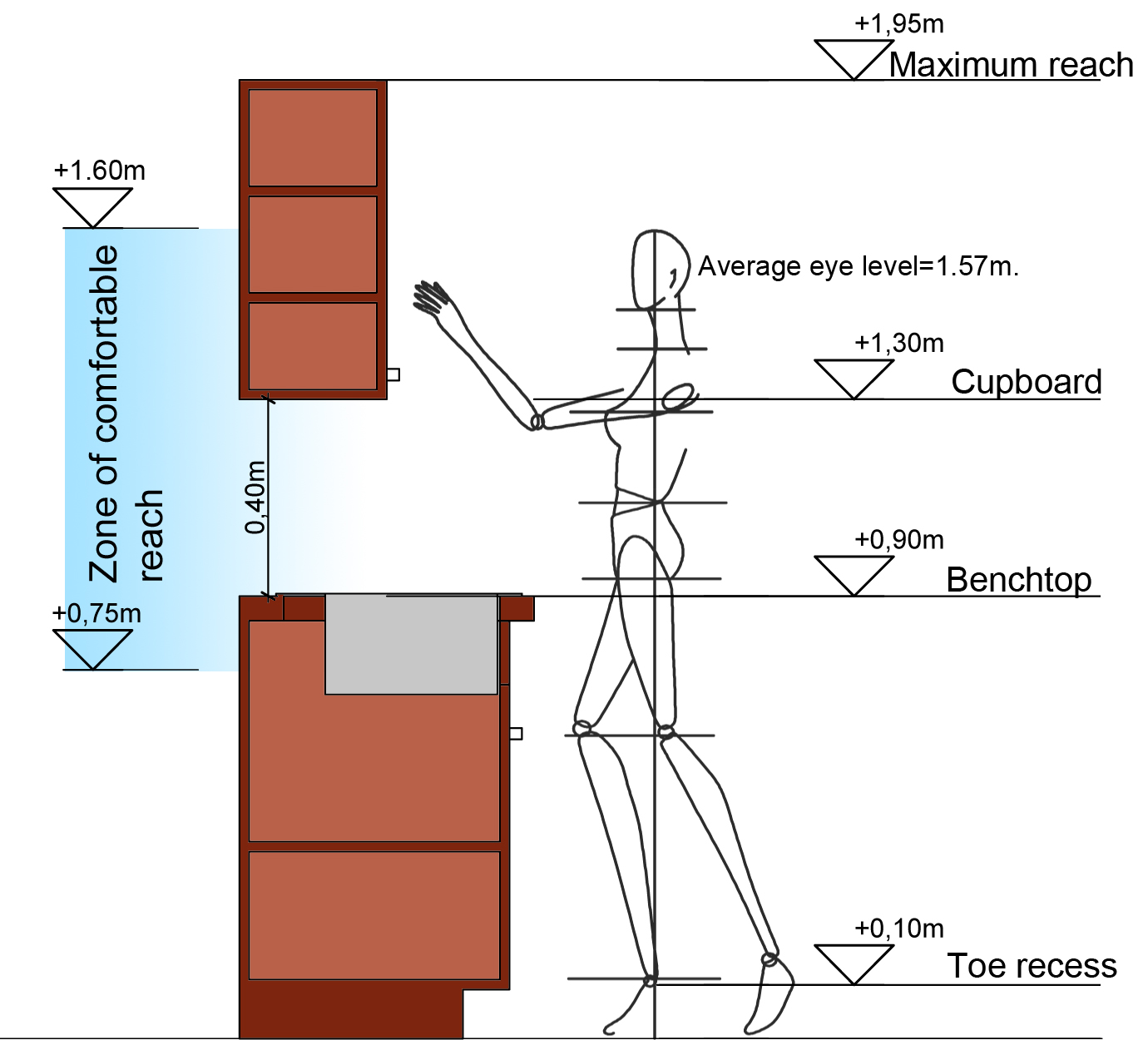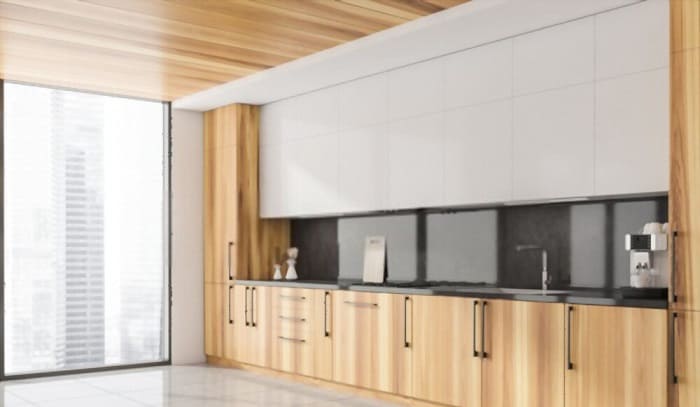Standard Height Considerations

The distance between cabinets and countertops plays a crucial role in kitchen functionality and user comfort. This height, often referred to as the “countertop height,” directly impacts the ease of use and ergonomic experience while preparing food, cleaning, or working in the kitchen.
Standard Ranges and Common Variations
The standard countertop height is generally considered to be between 34 and 36 inches, although variations exist based on factors such as individual height, the intended use of the countertop, and the type of countertop material used. For instance, a kitchen designed for a taller user might require a higher countertop, while a kitchen dedicated primarily to baking might benefit from a slightly lower countertop to facilitate comfortable rolling and kneading.
Ergonomic Considerations, Height between cabinets and countertops
The ideal countertop height is determined by ergonomic principles, aiming to minimize strain and promote comfortable posture during kitchen activities. A well-designed countertop height allows for comfortable reach and minimizes the need to bend or stretch excessively. This, in turn, reduces the risk of back pain, neck strain, and other musculoskeletal issues that can arise from prolonged work in an uncomfortable position.
Countertop Material and Ideal Height
The type of countertop material can influence the ideal countertop height. For example, a solid surface countertop, known for its durability and ease of cleaning, might require a slightly higher height compared to a laminate countertop, which is typically thinner. Similarly, a butcher block countertop, often preferred for its natural aesthetic and resilience, might be slightly thicker, requiring a slightly higher countertop height for optimal functionality.
Examples of Countertop Material Impact
- Solid surface countertops: These countertops are known for their durability and ease of cleaning. Due to their thickness, they often require a slightly higher countertop height for optimal functionality.
- Laminate countertops: These countertops are a popular choice due to their affordability and wide range of styles. They are typically thinner than solid surface countertops, allowing for a slightly lower countertop height.
- Butcher block countertops: These countertops are known for their natural aesthetic and resilience. They are often thicker than other countertop materials, requiring a slightly higher countertop height for optimal functionality.
Design and Functionality

The height between cabinets and countertops is a crucial factor in kitchen design, significantly impacting workflow and storage efficiency. A well-designed kitchen considers the ergonomic aspects of this relationship, ensuring comfortable and efficient movement while maximizing storage potential.
Impact on Workflow and Storage
The height between cabinets and countertops directly influences the ease and comfort of performing kitchen tasks. A countertop that is too high can strain your back and shoulders, while a countertop that is too low can cause discomfort in your wrists and arms. Similarly, the height of cabinets affects accessibility and storage efficiency. Cabinets that are too high can be difficult to reach, while cabinets that are too low can obstruct movement and limit the storage space available.
Designing a Kitchen with Varying Heights
A kitchen layout can incorporate varying cabinet and countertop heights to optimize functionality and accommodate different user needs. For example, a kitchen can feature a lower countertop for tasks like food preparation, while a higher countertop can be used for dining or serving. This approach provides flexibility and caters to different heights and preferences. Similarly, cabinets can be designed at different heights to optimize storage accessibility. Lower cabinets can be used for frequently used items, while upper cabinets can be used for less frequently used items or items that are less frequently accessed.
Examples of Kitchens with Unique Configurations
Many kitchens feature unique cabinet and countertop configurations to enhance functionality and address specific needs. One common example is the “island with a breakfast bar.” This configuration features a lower countertop for food preparation and a higher countertop for seating, creating a versatile space for both cooking and dining. Another example is the “walk-in pantry,” which features high shelves and drawers that provide ample storage space for pantry items. This configuration maximizes storage capacity and can be particularly beneficial in smaller kitchens where space is limited.
Customization and Accessibility: Height Between Cabinets And Countertops

The space between cabinets and countertops, a seemingly minor detail, can significantly impact a kitchen’s functionality and accessibility. This section explores the advantages and challenges of tailoring this height for individual needs, including strategies for creating accessible kitchens for people with disabilities.
Customizing Countertop and Cabinet Heights
Customizing the height between cabinets and countertops offers numerous benefits, particularly for individuals with varying heights and physical capabilities. Tailoring these dimensions can enhance comfort, reduce strain, and promote better ergonomics. For instance, a shorter individual might find it easier to work with a lower countertop, while a taller person might prefer a higher countertop for improved posture and reduced back strain.
The challenge lies in balancing the benefits of customization with the potential cost and complexity of implementing such changes. Customizing countertop and cabinet heights often requires specialized construction, which can be more expensive than using standard-sized components. Furthermore, adjusting the height might necessitate alterations to other elements of the kitchen, such as plumbing, electrical wiring, or ventilation systems, adding to the overall cost and complexity.
Designing Accessible Kitchens
Creating accessible kitchens for people with disabilities requires careful consideration of various factors, including the height of countertops, cabinets, and appliances. The goal is to design a kitchen that is easy to navigate, use, and maintain for individuals with different mobility and reach limitations.
Design Strategies for Accessible Kitchens
- Adjustable Countertop Heights: Adjustable countertops offer a flexible solution for kitchens accommodating individuals with varying heights or changing needs. These countertops can be raised or lowered using mechanisms like electric motors, gas-assisted struts, or manual cranks. This adjustability allows users to set the countertop height to their preferred level, ensuring comfort and ease of use.
- Lowered Cabinets: Lowering the height of base cabinets can improve accessibility for individuals who have difficulty reaching standard-height cabinets. This can be achieved by using shorter cabinet units or by adjusting the cabinet legs. Lowered cabinets provide easier access to storage and make it easier to reach items stored inside.
- Open Shelving: Open shelving offers an alternative to traditional cabinets, providing easier access to frequently used items. This approach eliminates the need to open doors or drawers, making it easier for people with limited mobility or reach to access items. Open shelving also allows for better visibility and organization of kitchen items.
- Pull-out Shelves and Drawers: Pull-out shelves and drawers are designed to make it easier to reach items stored in cabinets. These features extend outwards, allowing users to access items without bending or straining. Pull-out shelves and drawers are particularly helpful for individuals with limited mobility or reach.
- Knee Space: Providing adequate knee space beneath countertops and cabinets is crucial for wheelchair users. A minimum of 27 inches of knee space is recommended to allow for comfortable maneuvering and access. This space also allows for the use of assistive devices like knee scooters or walkers.
Comparing and Contrasting Height Adjustment Methods
There are several methods for adjusting countertop and cabinet heights, each with its own advantages and disadvantages.
Adjustable Legs
Adjustable legs are a relatively simple and cost-effective way to adjust the height of countertops and cabinets. These legs are typically made of metal and can be adjusted using a screw mechanism. Adjustable legs offer flexibility and are easy to install, making them a popular choice for DIY projects. However, adjustable legs may not provide the same level of stability as custom-built cabinets and can be prone to wear and tear over time.
Custom-Built Cabinets
Custom-built cabinets offer the most flexibility and control over countertop and cabinet heights. These cabinets are built to precise specifications, ensuring a perfect fit and desired height. Custom-built cabinets provide a more permanent and robust solution compared to adjustable legs, offering superior stability and durability. However, custom-built cabinets are typically more expensive than standard cabinets and require specialized construction, potentially increasing the overall project cost.
The optimal height between cabinets and countertops is a crucial consideration in kitchen design, as it impacts both functionality and aesthetics. While functionality is paramount, aesthetics are equally important, and a black accent wall can dramatically enhance the visual appeal of any space, including a kitchen.
A black accent wall can create a striking contrast against the light cabinetry and countertops, adding depth and sophistication to the overall design. To learn more about incorporating a black accent wall into your bedroom, explore this informative article on black accent wall bedrooms.
Returning to the kitchen, the ideal countertop height should allow for comfortable reach and minimize strain, making the space more user-friendly.
The optimal height between cabinets and countertops is a crucial consideration for both functionality and aesthetics. A well-designed kitchen should strike a balance between providing ample workspace and ensuring comfortable reach. When considering a maroon accent wall bedroom , it’s essential to remember that color choices can significantly impact the perceived size and ambiance of a space.
Similarly, the height between cabinets and countertops in a kitchen can affect the flow of movement and overall sense of spaciousness.
